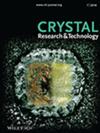Facile Synthesis, Crystal Structure, Spectral Characterization, Quantum Chemical Calculations, and Hirshfeld Surface Analysis of 5‐Chloro‐3‐Methoxy‐4‐Hydroxybenzaldehyde
IF 1.9
4区 材料科学
Q3 CRYSTALLOGRAPHY
引用次数: 0
Abstract
This article deals with synthesis, growth, structure, and characterization of 5‐chloro‐3‐methoxy‐4‐hydroxybenzaldehyde (5CMHBA or 5‐chlorovanillin) single crystals. A facile one‐pot method is employed for the chlorination of vanillin using N‐chlorosuccinimide. After chlorination, the single crystals of 5CMHBA are grown by slow evaporation solution growth technique. Grown crystals are subjected to single crystal X‐ray diffraction (SXRD), Fourier Transform Infrared (FTIR), and Thermogravimetric‐Differential Thermal Analysis (TG‐DTA). 5CMHBA crystallizes in the tetragonal crystal system with the space group P42/n. Vibrational characteristics are studied using FTIR. Further, thermal studies of the crystal are carried out using simultaneous TG‐DTA thermal analyzer. The molecular structure and its intermolecular interactions are studied by applying time–dependent density functional theory (TD‐DFT) using Gaussian 09 program and Hirshfeld surface analysis. A lesser energy gap of the 5CMHBA compared to that of vanillin shows the high reactivity of the molecule. Dipole moment, polarizability, and hyper‐polarizability are calculated in the molecular level and found to have greater polarizability than vanillin and also higher in order than that of standard urea molecule. This reveals the suitability of the molecule for nonlinear optical applications. The intermolecular interactions and porosity are analyzed and compared with vanillin and its polymorphs by Hirshfeld surface analysis.5‐氯‐3‐甲氧基‐4‐羟基苯甲醛的易合成、晶体结构、光谱表征、量子化学计算和Hirshfeld表面分析
本文研究了5‐氯‐3‐甲氧基‐4‐羟基苯甲醛(5CMHBA或5‐氯香草醛)单晶的合成、生长、结构和表征。用N -氯丁二酰亚胺进行香兰素的一锅氯化反应。氯化后,采用慢蒸发溶液生长技术生长出5CMHBA单晶。生长的晶体进行了单晶X射线衍射(SXRD),傅里叶变换红外(FTIR)和热重-差热分析(TG - DTA)。5CMHBA在空间群P42/n的四方晶系中结晶。用FTIR研究了其振动特性。此外,使用TG - DTA热分析仪对晶体进行了热研究。利用高斯09程序和Hirshfeld表面分析,应用时变密度泛函理论(TD‐DFT)研究了分子结构及其分子间相互作用。与香兰素相比,5CMHBA的能隙较小,表明该分子具有较高的反应活性。偶极矩、极化率和超极化率在分子水平上进行了计算,发现其极化率高于香兰素,也高于标准尿素分子。这揭示了该分子在非线性光学应用中的适用性。利用Hirshfeld表面分析法对其分子间相互作用和孔隙度进行了分析,并与香兰素及其多晶体进行了比较。
本文章由计算机程序翻译,如有差异,请以英文原文为准。
求助全文
约1分钟内获得全文
求助全文
来源期刊
自引率
6.70%
发文量
121
审稿时长
1.9 months
期刊介绍:
The journal Crystal Research and Technology is a pure online Journal (since 2012).
Crystal Research and Technology is an international journal examining all aspects of research within experimental, industrial, and theoretical crystallography. The journal covers the relevant aspects of
-crystal growth techniques and phenomena (including bulk growth, thin films)
-modern crystalline materials (e.g. smart materials, nanocrystals, quasicrystals, liquid crystals)
-industrial crystallisation
-application of crystals in materials science, electronics, data storage, and optics
-experimental, simulation and theoretical studies of the structural properties of crystals
-crystallographic computing

 求助内容:
求助内容: 应助结果提醒方式:
应助结果提醒方式:


